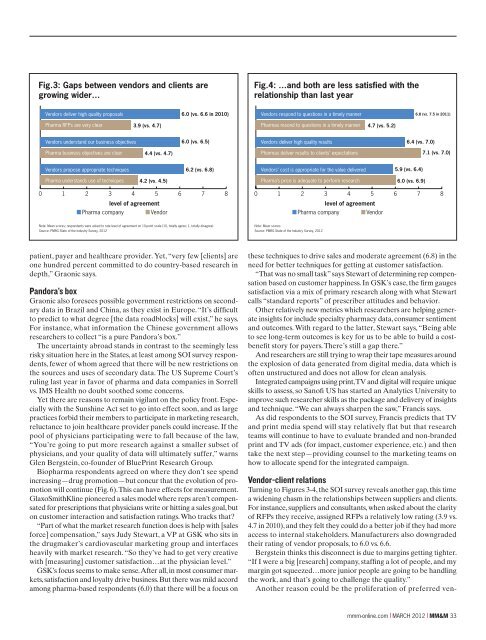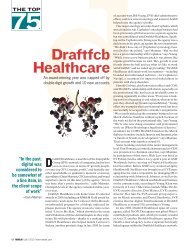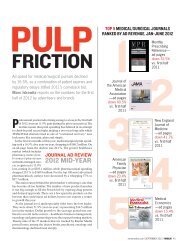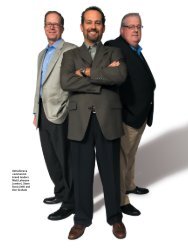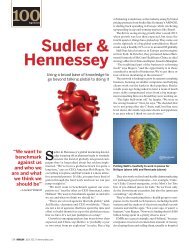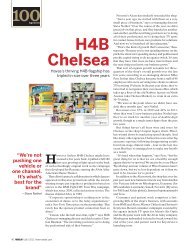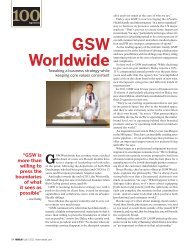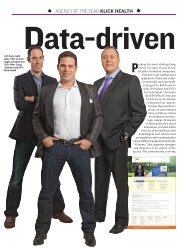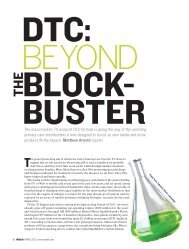Analyze this - Medical Marketing and Media
Analyze this - Medical Marketing and Media
Analyze this - Medical Marketing and Media
You also want an ePaper? Increase the reach of your titles
YUMPU automatically turns print PDFs into web optimized ePapers that Google loves.
Fig.3: Gaps between vendors <strong>and</strong> clients are<br />
growing wider…<br />
Vendors deliver high quality proposals<br />
Pharma RFPs are very clear<br />
Vendors underst<strong>and</strong> our business objectives<br />
Pharma business objectives are clear<br />
Vendors propose appropriate techniques<br />
Pharma underst<strong>and</strong>s use of techniques<br />
3.9 (vs. 4.7)<br />
4.4 (vs. 4.7)<br />
4.2 (vs. 4.5)<br />
6.0 (vs. 6.6 in 2010)<br />
6.0 (vs. 6.5)<br />
6.2 (vs. 6.8)<br />
0 1 2 3 4 5 6 7 8<br />
level of agreement<br />
Pharma company Vendor<br />
Note: Mean scores; respondents were asked to rate level of agreement on 10-point scale (10, totally agree; 1, totally disagree)<br />
Source: PMRG State of the Industry Survey, 2012<br />
patient, payer <strong>and</strong> healthcare provider. Yet, “very few [clients] are<br />
one hundred percent committed to do country-based research in<br />
depth,” Graonic says.<br />
P<strong>and</strong>ora’s box<br />
Graonic also foresees possible government restrictions on secondary<br />
data in Brazil <strong>and</strong> China, as they exist in Europe. “It’s difficult<br />
to predict to what degree [the data roadblocks] will exist,” he says.<br />
For instance, what information the Chinese government allows<br />
researchers to collect “is a pure P<strong>and</strong>ora’s box.”<br />
The uncertainty abroad st<strong>and</strong>s in contrast to the seemingly less<br />
risky situation here in the States, at least among SOI survey respondents,<br />
fewer of whom agreed that there will be new restrictions on<br />
the sources <strong>and</strong> uses of secondary data. The US Supreme Court’s<br />
ruling last year in favor of pharma <strong>and</strong> data companies in Sorrell<br />
vs. IMS Health no doubt soothed some concerns.<br />
Yet there are reasons to remain vigilant on the policy front. Especially<br />
with the Sunshine Act set to go into effect soon, <strong>and</strong> as large<br />
practices forbid their members to participate in marketing research,<br />
reluctance to join healthcare provider panels could increase. If the<br />
pool of physicians participating were to fall because of the law,<br />
“You’re going to put more research against a smaller subset of<br />
physicians, <strong>and</strong> your quality of data will ultimately suffer,” warns<br />
Glen Bergstein, co-founder of BluePrint Research Group.<br />
Biopharma respondents agreed on where they don’t see spend<br />
increasing—drug promotion—but concur that the evolution of promotion<br />
will continue (Fig. 6). This can have effects for measurement.<br />
GlaxoSmithKline pioneered a sales model where reps aren’t compensated<br />
for prescriptions that physicians write or hitting a sales goal, but<br />
on customer interaction <strong>and</strong> satisfaction ratings. Who tracks that?<br />
“Part of what the market research function does is help with [sales<br />
force] compensation,” says Judy Stewart, a VP at GSK who sits in<br />
the drugmaker’s cardiovascular marketing group <strong>and</strong> interfaces<br />
heavily with market research. “So they’ve had to get very creative<br />
with [measuring] customer satisfaction…at the physician level.”<br />
GSK’s focus seems to make sense. After all, in most consumer markets,<br />
satisfaction <strong>and</strong> loyalty drive business. But there was mild accord<br />
among pharma-based respondents (6.0) that there will be a focus on<br />
uerosTo commoDo oDionul<br />
Fig.4: …<strong>and</strong> both are less satisfied with the<br />
relationship than last year<br />
Vendors respond to questions in a timely manner<br />
Pharmas resond to questions in a timely manner<br />
Vendors deliver high quality results<br />
Pharmas deliver results to clients’ expectations<br />
Vendors’ cost is appropriate for the value delivered<br />
Pharma’s price is adequate to perform research<br />
0 1 2 3 4 5 6 7 8<br />
Note: Mean scores<br />
Source: PMRG State of the Industry Survey, 2012<br />
level of agreement<br />
4.7 (vs. 5.2)<br />
Pharma company Vendor<br />
6.8 (vs. 7.5 in 2011)<br />
6.4 (vs. 7.0)<br />
5.9 (vs. 6.4)<br />
6.0 (vs. 6.9)<br />
7.1 (vs. 7.0)<br />
these techniques to drive sales <strong>and</strong> moderate agreement (6.8) in the<br />
need for better techniques for getting at customer satisfaction.<br />
“That was no small task” says Stewart of determining rep compensation<br />
based on customer happiness. In GSK’s case, the firm gauges<br />
satisfaction via a mix of primary research along with what Stewart<br />
calls “st<strong>and</strong>ard reports” of prescriber attitudes <strong>and</strong> behavior.<br />
Other relatively new metrics which researchers are helping generate<br />
insights for include specialty pharmacy data, consumer sentiment<br />
<strong>and</strong> outcomes. With regard to the latter, Stewart says, “Being able<br />
to see long-term outcomes is key for us to be able to build a costbenefit<br />
story for payers. There’s still a gap there.”<br />
And researchers are still trying to wrap their tape measures around<br />
the explosion of data generated from digital media, data which is<br />
often unstructured <strong>and</strong> does not allow for clean analysis.<br />
Integrated campaigns using print, TV <strong>and</strong> digital will require unique<br />
skills to assess, so Sanofi US has started an Analytics University to<br />
improve such researcher skills as the package <strong>and</strong> delivery of insights<br />
<strong>and</strong> technique. “We can always sharpen the saw,” Francis says.<br />
As did respondents to the SOI survey, Francis predicts that TV<br />
<strong>and</strong> print media spend will stay relatively flat but that research<br />
teams will continue to have to evaluate br<strong>and</strong>ed <strong>and</strong> non-br<strong>and</strong>ed<br />
print <strong>and</strong> TV ads (for impact, customer experience, etc.) <strong>and</strong> then<br />
take the next step—providing counsel to the marketing teams on<br />
how to allocate spend for the integrated campaign.<br />
Vendor-client relations<br />
Turning to Figures 3-4, the SOI survey reveals another gap, <strong>this</strong> time<br />
a widening chasm in the relationships between suppliers <strong>and</strong> clients.<br />
For instance, suppliers <strong>and</strong> consultants, when asked about the clarity<br />
of RFPs they receive, assigned RFPs a relatively low rating (3.9 vs.<br />
4.7 in 2010), <strong>and</strong> they felt they could do a better job if they had more<br />
access to internal stakeholders. Manufacturers also downgraded<br />
their rating of vendor proposals, to 6.0 vs. 6.6.<br />
Bergstein thinks <strong>this</strong> disconnect is due to margins getting tighter.<br />
“If I were a big [research] company, staffing a lot of people, <strong>and</strong> my<br />
margin got squeezed…more junior people are going to be h<strong>and</strong>ling<br />
the work, <strong>and</strong> that’s going to challenge the quality.”<br />
Another reason could be the proliferation of preferred ven-<br />
mmm-online.com x MARCH 2012 x MM&M 33


